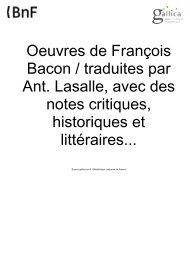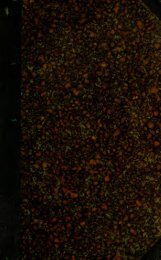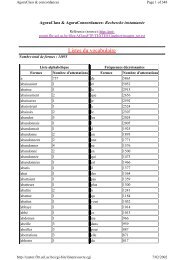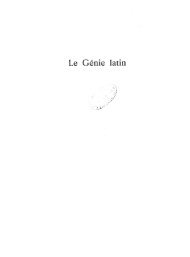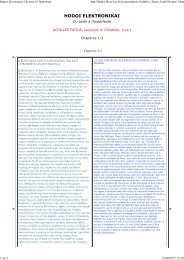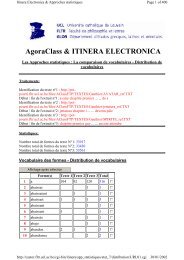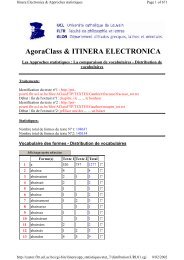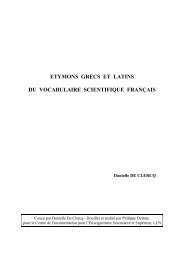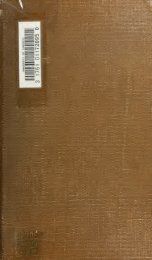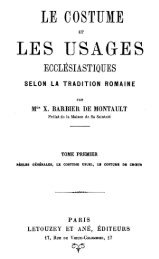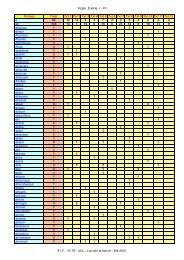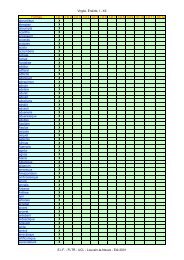The Etymologies of Isidore of Seville - Pot-pourri
The Etymologies of Isidore of Seville - Pot-pourri
The Etymologies of Isidore of Seville - Pot-pourri
Create successful ePaper yourself
Turn your PDF publications into a flip-book with our unique Google optimized e-Paper software.
380 XIX.xvi.1–xvii.12 <strong>Isidore</strong> <strong>of</strong> <strong>Seville</strong><br />
for the human being who was first made from mud<br />
(see Genesis 2:7).<br />
xvi. Pictures (De picturis) 1.Apictureisanimagerepresenting<br />
the appearance <strong>of</strong> some object, which, when<br />
viewed, leads the mind to remember. It is called ‘picture’<br />
(pictura) asifthewordwerefictura, for it is a made-up<br />
(fictus) image, and not the truth. Hence also the term<br />
‘painted’ (fucatus), that is, daubed with some artificial<br />
color and possessing no credibility or truth. Thus some<br />
pictures go beyond the substance <strong>of</strong> truth in their attention<br />
to color, and in their efforts to increase credibility<br />
move into falsehood, just as someone who paints a<br />
three-headed Chimera, or a Scylla as human in the upper<br />
half and girded with dogs’ heads below. 2.<strong>The</strong>Egyptians<br />
first discovered the picture when they outlined a person’s<br />
shadow with a line. It began like this, and was followed by<br />
the use <strong>of</strong> single colors, and afterwards by assortments<br />
<strong>of</strong> colors, so that gradually this art defined itself, and<br />
devised light and shadow and the differences in color.<br />
For this reason even now painters (pictor)firstdrawcertain<br />
shadows and the outlines <strong>of</strong> the images to come,<br />
and then fill in the colors, following the order in which<br />
the art was discovered.<br />
xvii. Colorings (De coloribus) 1.Colorings (color)are<br />
so named because they are perfected by the heat (calor)<br />
<strong>of</strong> fire or <strong>of</strong> the sun, or because in the beginning they<br />
used to be filtered(colere) sothat they would be as fine<br />
as possible. 2. Colorings either occur naturally or are<br />
manufactured. <strong>The</strong>y occur naturally, as for example, red<br />
ochre, red earth, Paraetonium, Melinum, Eretria, and<br />
gold-coloring. <strong>The</strong> others are manufactured either by<br />
artifice or by mixture.<br />
3.Redochre(sinopis)wasfound first along the Black<br />
Sea, whence it takes its name from the city Sinope. <strong>The</strong>re<br />
are three kinds: red, less-red, and something between<br />
these two. 4. Redearth (rubrica) issonamed because it<br />
is red (ruber) andsimilar to blood in color. It occurs in<br />
many places, but the best is from the Black Sea (Pontus),<br />
whence it is also called ‘Pontic.’ 5. Syrian(Syricum) isa<br />
pigment with a red color, with which the chapter-heads<br />
in books are written. It is also known as Phoenician, so<br />
called because it is collected in Syria on the shores <strong>of</strong><br />
the Red Sea, where the Phoenicians live. 6. Now,‘silk’<br />
(sericum)isone thing, and ‘Syrian’ (Syricum)isanother,<br />
for silk is a fiber that the Chinese (Seres; East Asians<br />
generally) export, while Syrian is a pigment that the Syrian<br />
Phoenicians gather at the shores <strong>of</strong> the Red Sea. It<br />
may also be counted among the manufactured pigments,<br />
for it is <strong>of</strong>ten made by being mixed either with red ocher<br />
or with vermilion (sandix).<br />
7.<strong>The</strong> Greeks are reported to have been the first to discover<br />
‘red lead’ (minium), in the soil <strong>of</strong> Ephesus. Spain is<br />
more abundant in this pigment than other regions, and<br />
for this reason it has given its name to a particular river<br />
(i.e. the Minius, present-day Miño). When distilled, it<br />
produces liquid silver (i.e. quicksilver). Some people say<br />
that this red lead is cinnabar. 8. Cinnabar (cinnabaris)<br />
is named from draco (gen. draconis,“dragon”) and barrus,<br />
that is, ‘elephant,’ for they say that it is the blood<br />
<strong>of</strong> dragons, shed when they entwine themselves around<br />
elephants. 7 <strong>The</strong> elephants charge, and the dragons are<br />
overpowered, and the gore they shed dyes the earth, and<br />
apigment is produced from what has stained the soil. It<br />
is a red-colored powder. 9.Although prasin, that is, green<br />
clay, is produced in mixed form in some lands, nevertheless<br />
the best is the Cyrenian, in Libya. 10. Chrysocolla is<br />
grass-green in color, so named because its veins are said<br />
to contain gold (cf. ,“gold”; ,“glue”). This<br />
occurs in Armenia, but the preferred variety comes from<br />
Macedonia. It is mined along with the metal copper, and<br />
where it is discovered, silver and indigo are also found,<br />
for veins <strong>of</strong> chrysocolla have a natural association with<br />
these substances.<br />
<strong>The</strong> pigment cypria is named from the island <strong>of</strong><br />
Cyprus, where it is found in quantity. 11. Sandarach<br />
(sandaraca) occurs on the island Topazus in the Red<br />
Sea. It has the color <strong>of</strong> cinnabar and the odor <strong>of</strong> sulfur.<br />
It is found in gold and silver mines, and the redder<br />
it is and the worse it smells the better its quality.<br />
However, ‘white lead’ (cerussa), if it is baked in a furnace,<br />
produces sandarach, which as a result has a flamelike<br />
color. But if it is baked mixed with an equal part<br />
<strong>of</strong> red earth, it yields vermilion (sandix). 12. Arsenic<br />
(arsenicum), which Latin speakers call auripigmentum<br />
(“orpiment,” lit. “gold-pigment”) because <strong>of</strong> its color,<br />
is collected at the Black Sea from goldmine material,<br />
where sandarach is also found. <strong>The</strong> best arsenic takes<br />
on a golden color. It is pure and easily broken along the<br />
course <strong>of</strong> its veins. That which is paler or like sandarach<br />
7 Cinnabar (mercury sulfide) is also called ‘dragon’s blood’; vermilion<br />
is made from it.



